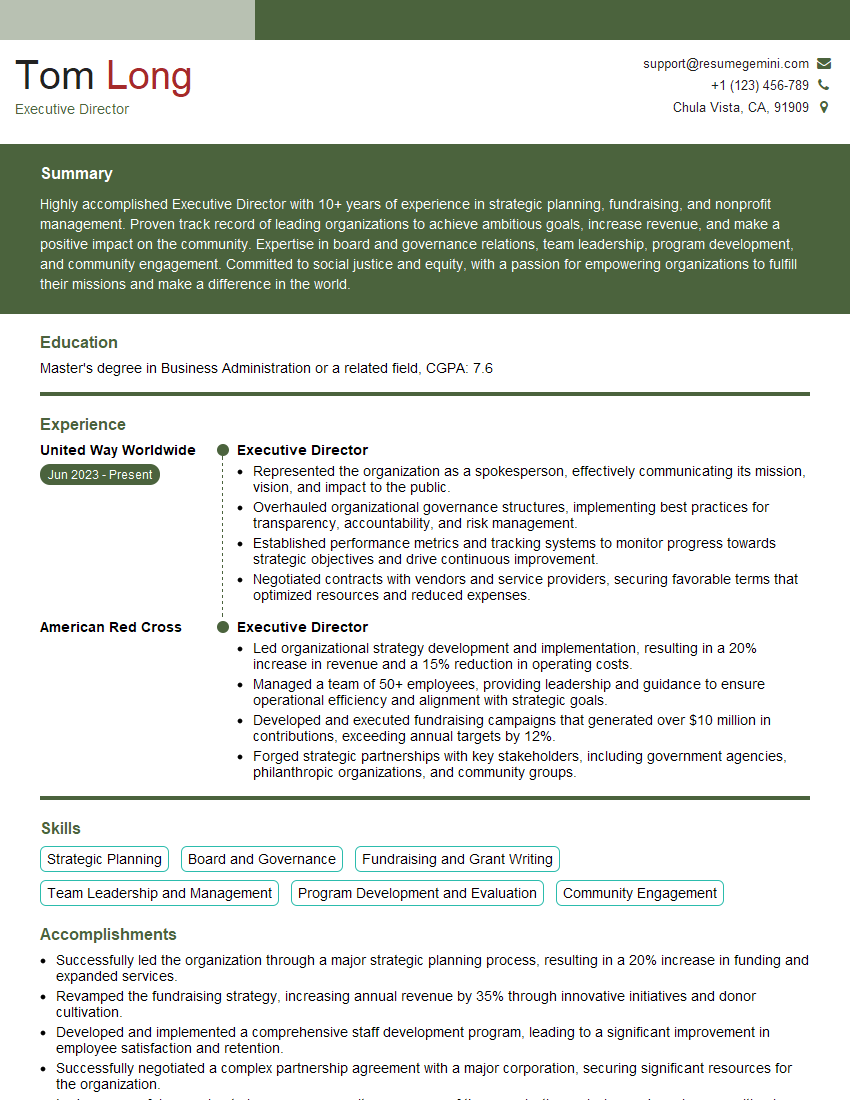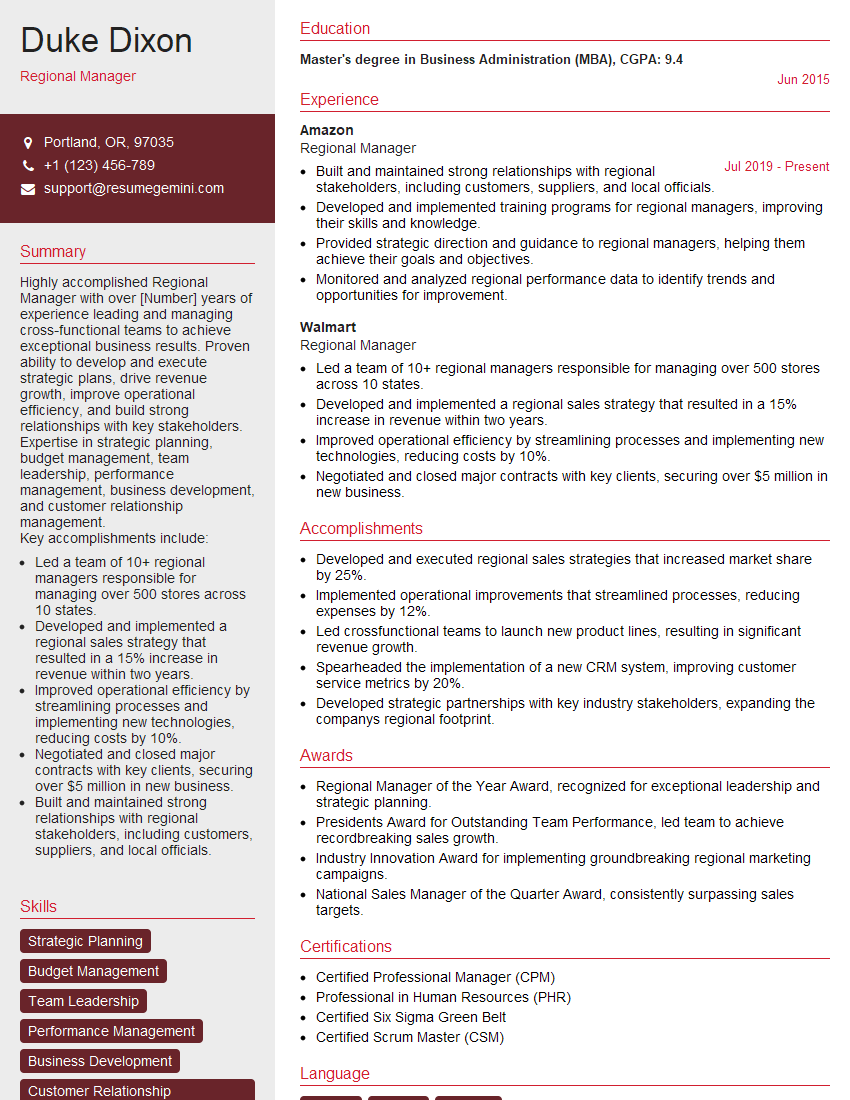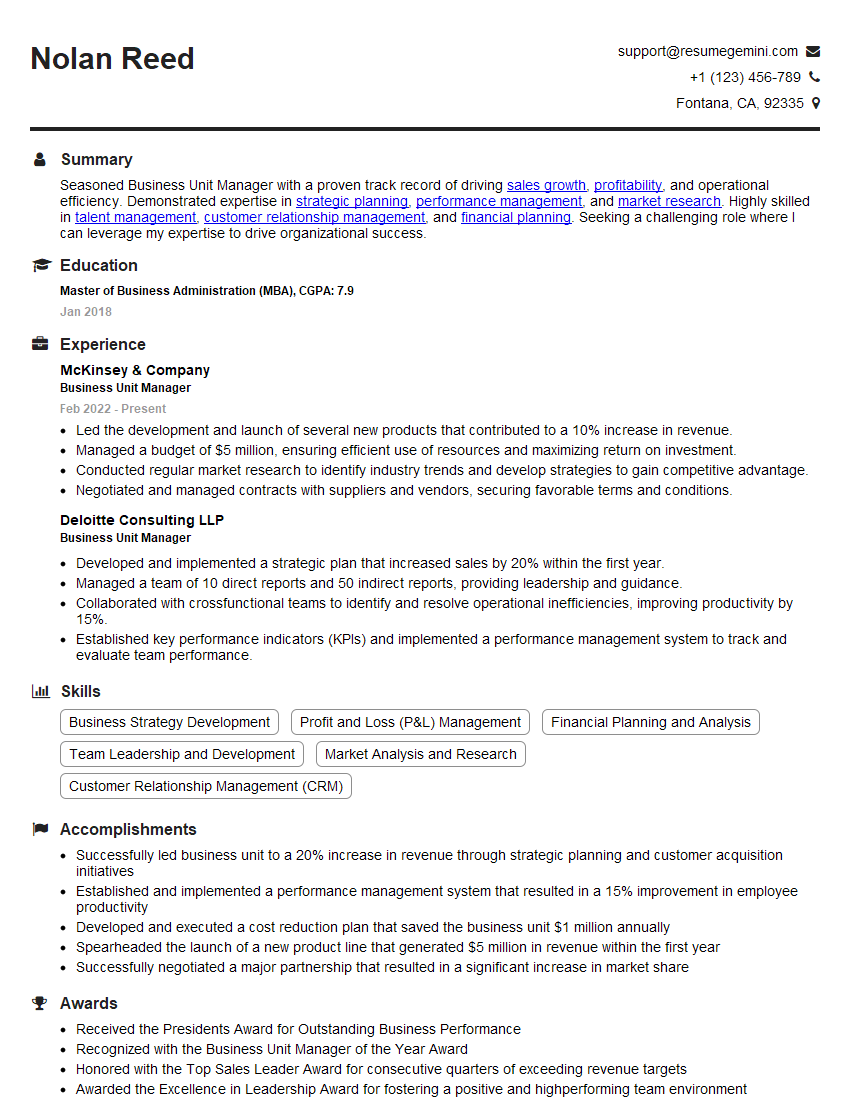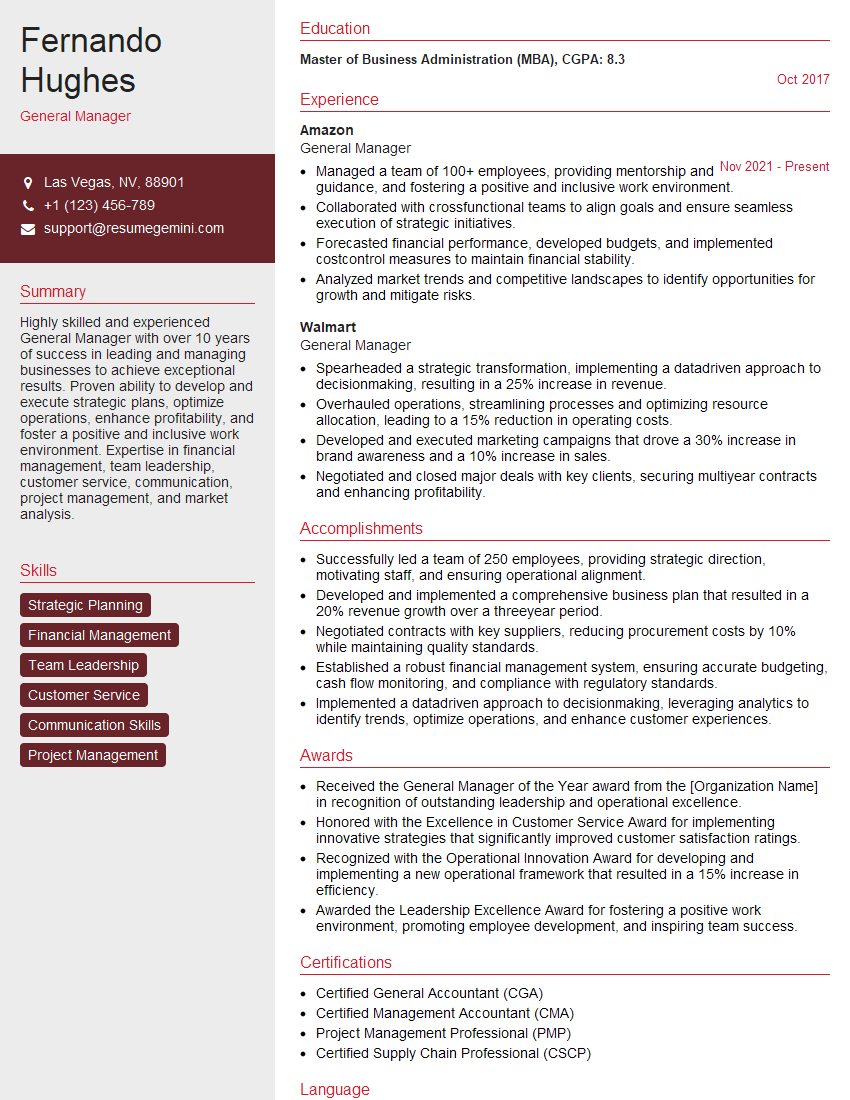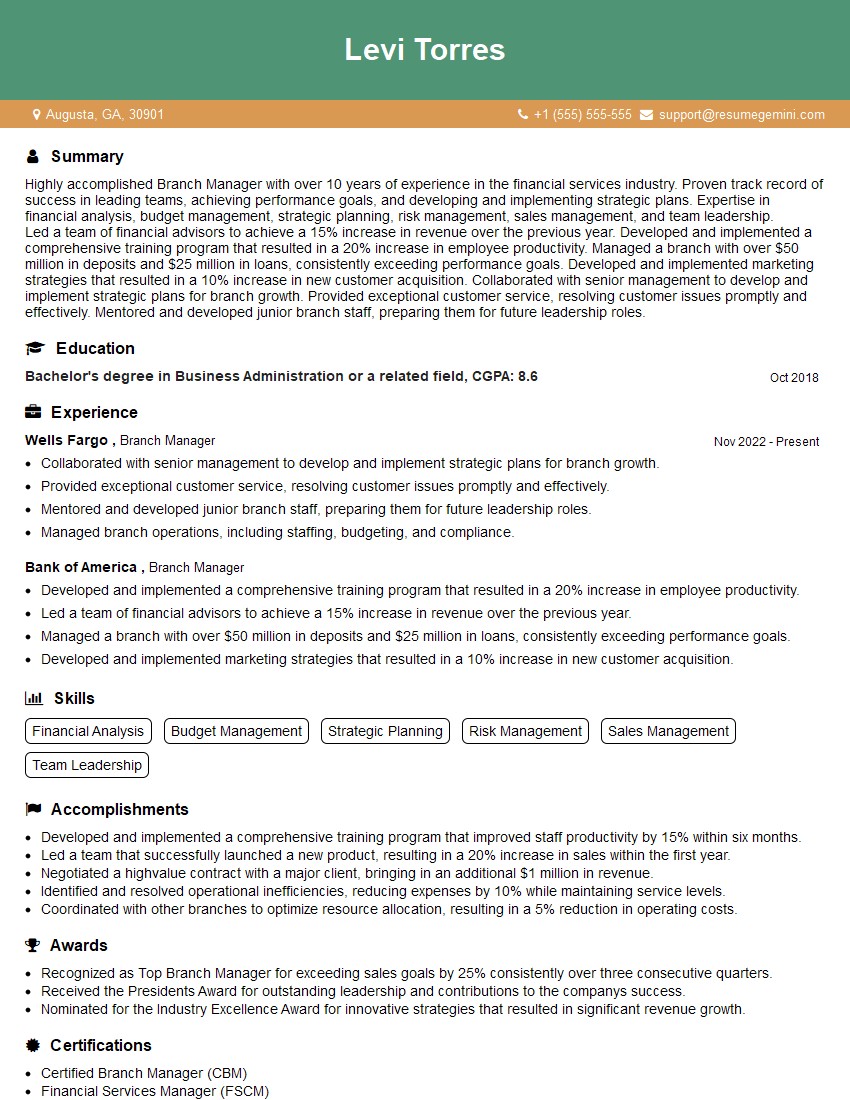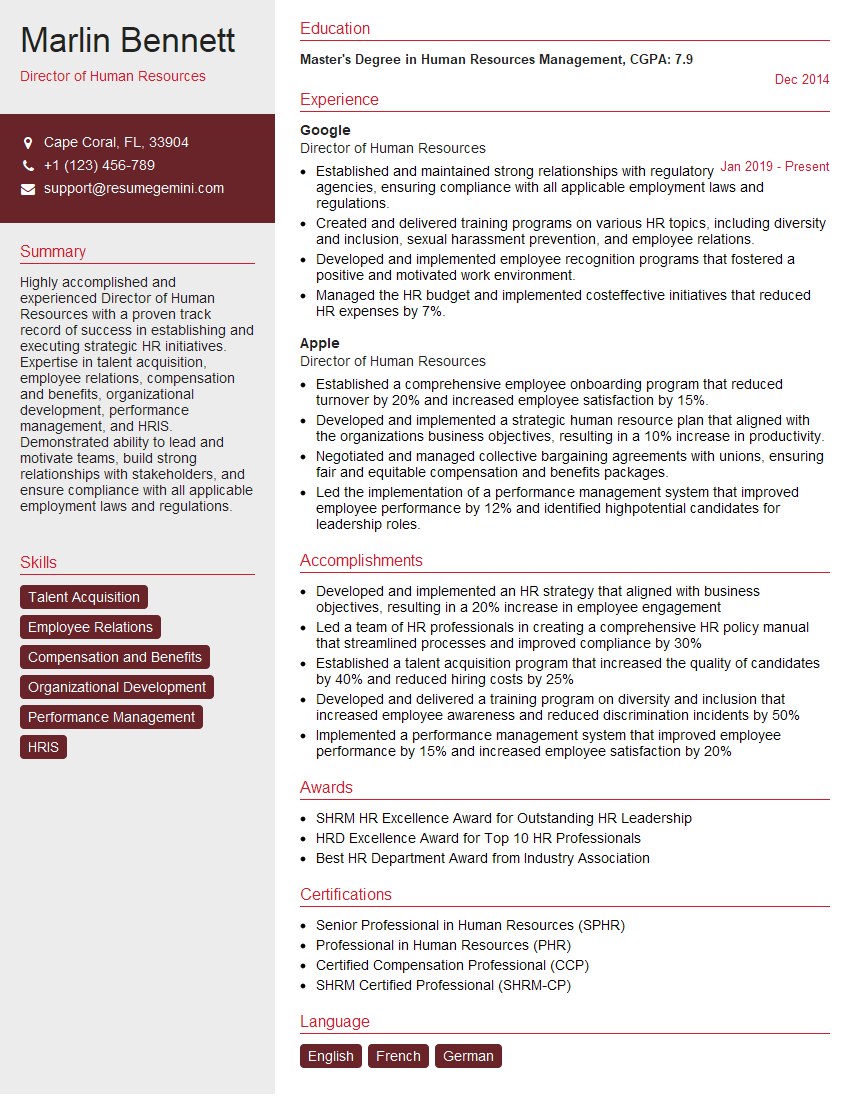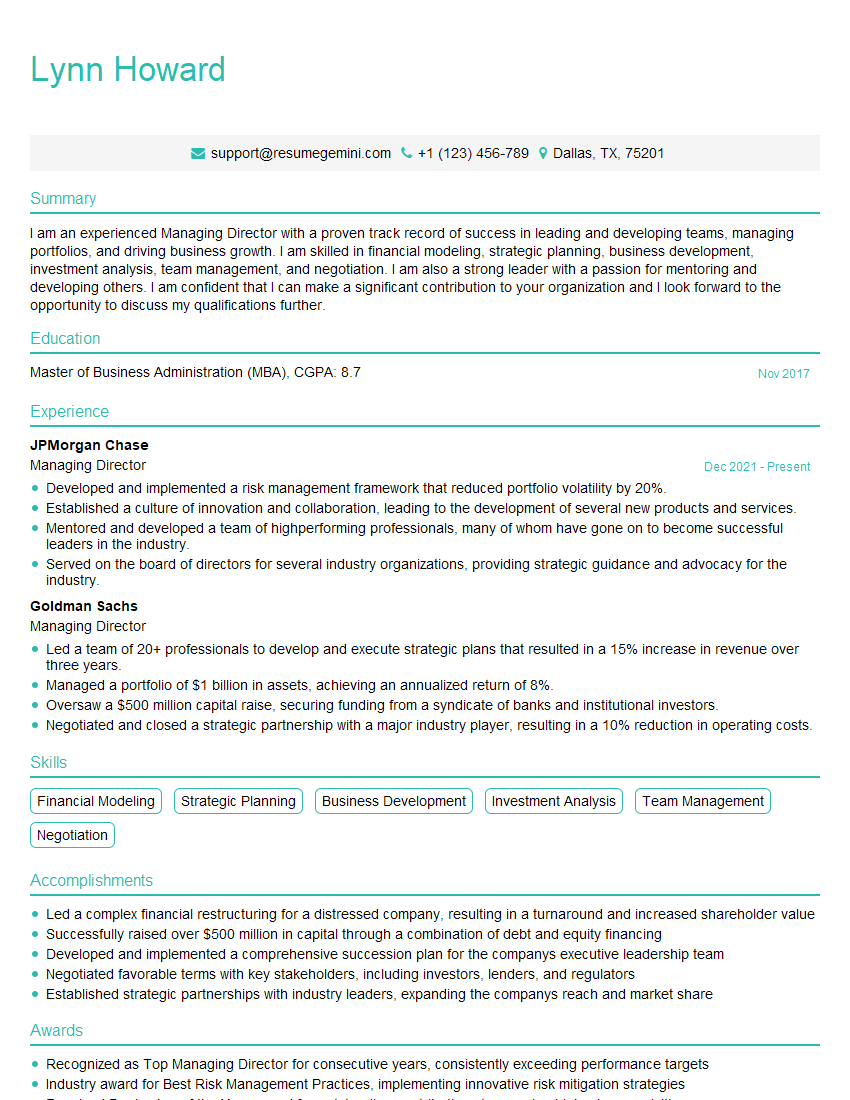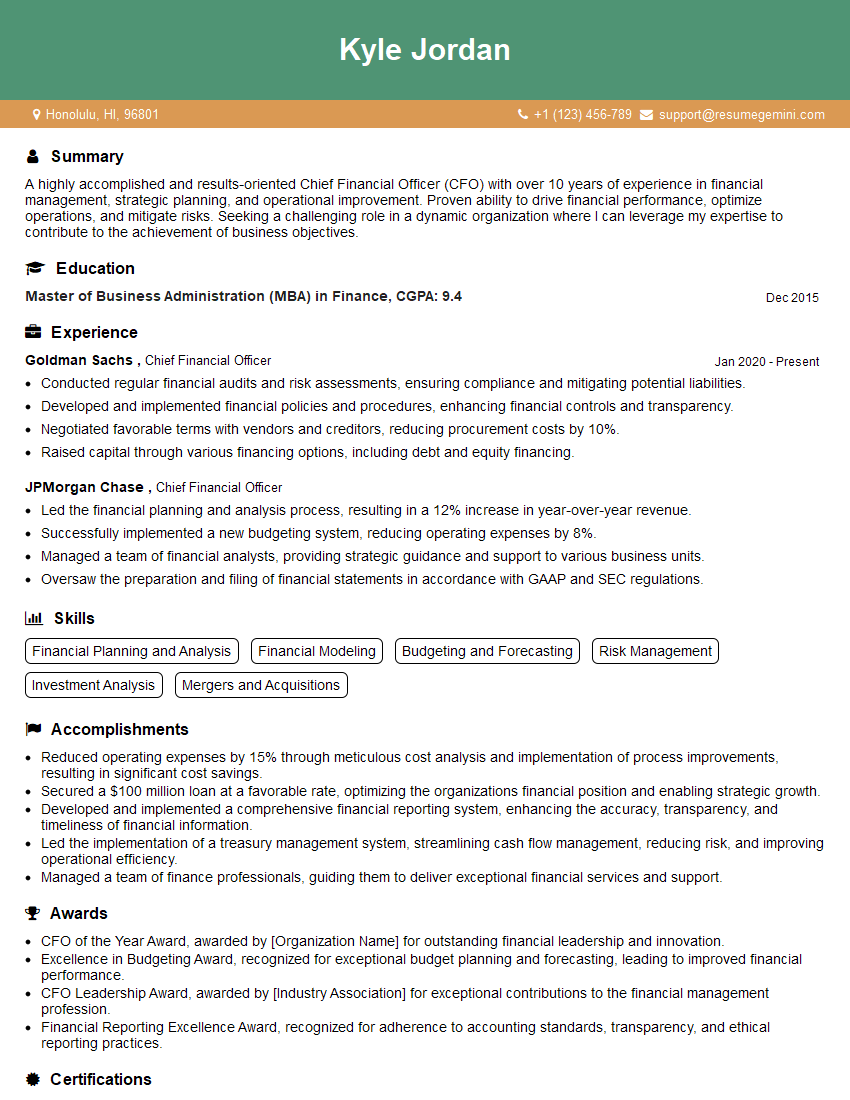Cracking a skill-specific interview, like one for Company Management, requires understanding the nuances of the role. In this blog, we present the questions you’re most likely to encounter, along with insights into how to answer them effectively. Let’s ensure you’re ready to make a strong impression.
Questions Asked in Company Management Interview
Q 1. Explain your experience in strategic planning and execution within a company.
Strategic planning and execution are the cornerstones of successful company management. It involves setting a clear vision, defining achievable goals, and developing a roadmap to reach them. My approach is multi-faceted and iterative. First, I conduct thorough market research and competitive analysis to identify opportunities and threats. Then, I collaborate with cross-functional teams – marketing, sales, operations, finance – to develop a comprehensive strategic plan. This includes setting Key Performance Indicators (KPIs) and defining clear roles and responsibilities. Execution involves regular monitoring of progress against KPIs, adapting the plan as needed based on performance data and market dynamics, and fostering a culture of accountability. For example, in my previous role at Acme Corp, we identified a gap in the market for a new software feature. Our strategic plan involved developing and launching this feature within a six-month timeframe, which involved allocating resources, setting milestones, and consistently tracking progress using Agile methodologies. The successful launch significantly increased market share and customer satisfaction.
Q 2. Describe your approach to managing budgets and resources effectively.
Effective budget and resource management is crucial for organizational sustainability and growth. My approach centers around a three-pronged strategy: planning, monitoring, and controlling. I begin by creating a detailed budget based on forecasted revenue, expenses, and resource allocation. This involves prioritizing projects based on their strategic alignment and potential ROI (Return on Investment). Throughout the fiscal year, I meticulously monitor actual spending against the budget, identifying any variances early on. Regular reporting and analysis are key to identifying potential issues. Finally, I implement corrective measures as needed. For example, if a project is over budget, I might explore options such as streamlining processes, renegotiating contracts, or reallocating resources from lower-priority projects. This proactive approach ensures that resources are utilized efficiently and effectively, maximizing organizational value.
Q 3. How do you handle conflicting priorities and deadlines in a fast-paced environment?
Handling conflicting priorities and deadlines in a fast-paced environment requires a structured and adaptable approach. I utilize prioritization frameworks like the Eisenhower Matrix (urgent/important), which helps me categorize tasks and focus on high-impact activities first. Open communication with team members is vital. I clearly articulate expectations and deadlines, ensuring everyone understands the priorities and the rationale behind them. If necessary, I may need to negotiate deadlines or re-allocate resources to ensure that critical tasks are completed on time. This might involve delegating tasks, seeking external support, or making tough decisions about which projects to postpone. Think of it like air traffic control: managing multiple flights (projects) simultaneously, ensuring each one reaches its destination (deadline) safely and efficiently.
Q 4. Describe a situation where you had to make a difficult decision impacting the company’s performance. What was the outcome?
During a period of economic downturn at Beta Inc., I had to make the difficult decision to restructure a department, resulting in layoffs. This was a necessary step to ensure the long-term viability of the company. The decision-making process involved a thorough analysis of the financial situation, performance data, and potential alternatives. I focused on retaining key employees, providing severance packages and outplacement services to those affected, and transparently communicating the reasons behind the restructuring. While the outcome was emotionally challenging for everyone involved, the restructuring ultimately resulted in improved efficiency and profitability, preventing a more extensive company-wide layoff. The experience taught me the importance of empathy, transparency, and decisive action in challenging circumstances.
Q 5. What metrics do you use to measure the success of your management efforts?
Measuring the success of my management efforts relies on a combination of quantitative and qualitative metrics. Quantitative metrics include key financial indicators such as revenue growth, profitability, return on investment (ROI), and efficiency ratios. They provide objective measures of performance. Qualitative metrics are also crucial and include employee satisfaction, team cohesion, customer satisfaction, and market share. For example, improved employee satisfaction can lead to increased productivity and reduced turnover. Combining these different metrics offers a holistic view of success, ensuring that we’re not only meeting financial targets but also fostering a positive and productive work environment.
Q 6. How do you foster a positive and productive work environment?
Fostering a positive and productive work environment is paramount for achieving organizational goals. My approach centers on open communication, mutual respect, and a culture of collaboration. I encourage open dialogue, providing regular feedback and creating opportunities for team members to share their ideas and concerns. Recognizing and rewarding achievements – both big and small – is essential to boosting morale and motivation. Promoting work-life balance and employee well-being is equally critical. A healthy and happy workforce is a productive workforce. For instance, I’ve implemented flexible work arrangements and team-building activities to enhance employee engagement and camaraderie. Creating a sense of community and shared purpose is key to building a strong and positive work environment.
Q 7. Describe your experience with performance management and employee development.
Performance management and employee development are integral aspects of my management style. I utilize a combination of methods, including regular one-on-one meetings to discuss performance, provide feedback, and identify areas for improvement. I establish clear performance expectations and goals, ensuring that employees understand what is expected of them. Providing constructive feedback, both positive and negative, is critical. I actively seek to identify opportunities for employee development, offering training programs, mentorship opportunities, and encouraging employees to pursue professional certifications. I believe in investing in the growth of my team members because their success directly contributes to the success of the organization. For instance, I’ve successfully mentored several junior employees who have been promoted to senior roles, showcasing the effectiveness of my approach.
Q 8. How do you identify and address potential risks to the company’s operations?
Identifying and addressing potential risks is crucial for operational stability. My approach involves a three-pronged strategy: proactive risk assessment, risk mitigation planning, and continuous monitoring.
- Proactive Risk Assessment: This involves regularly conducting comprehensive risk assessments, utilizing frameworks like SWOT analysis (Strengths, Weaknesses, Opportunities, Threats) and PESTLE analysis (Political, Economic, Social, Technological, Legal, Environmental). For example, I would analyze market trends, competitor actions, regulatory changes, and potential supply chain disruptions.
- Risk Mitigation Planning: Once potential risks are identified, we develop mitigation strategies. This might involve developing contingency plans (e.g., having backup suppliers to mitigate supply chain issues), implementing robust security protocols (e.g., cybersecurity measures to protect against data breaches), or investing in insurance to cover potential financial losses.
- Continuous Monitoring: Risk is dynamic. I ensure ongoing monitoring of the operational environment and regularly review and update our risk assessment and mitigation plans. Key performance indicators (KPIs) are tracked to detect early warning signs of emerging threats.
For instance, during my time at Acme Corp, we anticipated a potential drop in sales due to a new competitor entering the market. We proactively launched a new marketing campaign and developed a cost-reduction strategy, successfully mitigating the anticipated negative impact.
Q 9. What is your experience with change management and organizational restructuring?
Change management and organizational restructuring are critical aspects of maintaining a company’s competitiveness. My experience encompasses leading teams through significant transformations, focusing on minimizing disruption and maximizing employee buy-in.
My approach is grounded in a structured methodology, including:
- Communication: Transparent and consistent communication is paramount. I ensure everyone understands the ‘why’ behind the change, addressing concerns and fostering a sense of shared purpose.
- Planning: Detailed planning is essential. This includes defining clear objectives, outlining timelines, allocating resources, and establishing key performance indicators (KPIs) to measure progress.
- Training & Development: Employees need the skills and knowledge to succeed in the new structure. We provide adequate training and support to ensure a smooth transition.
- Employee Engagement: I actively solicit feedback and involve employees in the change process. This fosters a sense of ownership and commitment, leading to greater success.
In a previous role at Beta Inc., I successfully led the restructuring of the sales department, streamlining processes and improving efficiency by 20%. This involved introducing new CRM software, redefining roles and responsibilities, and implementing comprehensive training programs.
Q 10. How do you build and maintain strong relationships with stakeholders?
Building and maintaining strong stakeholder relationships is crucial for long-term success. My approach involves proactive communication, empathy, and a commitment to mutual benefit.
- Active Listening & Understanding: I make a conscious effort to understand the needs, concerns, and perspectives of all stakeholders – from employees and customers to investors and regulators.
- Transparent Communication: Open and honest communication builds trust. I regularly update stakeholders on progress, challenges, and opportunities.
- Collaboration & Partnership: I foster collaborative relationships, working with stakeholders to achieve shared goals. This involves actively seeking their input and incorporating their feedback into decision-making processes.
- Relationship Building: I invest time in building personal relationships based on mutual respect and understanding. This includes regular meetings, informal communication, and demonstrating genuine concern for their well-being.
For example, during a challenging period at Gamma Co., I proactively communicated with investors, explaining the situation and outlining our plans for recovery. This transparent approach maintained their confidence and ensured continued support.
Q 11. Explain your understanding of different leadership styles and when each style is most effective.
Effective leadership requires adaptability, choosing the most appropriate style for the situation and the team. Different leadership styles include:
- Transformational Leadership: Inspiring and motivating teams to achieve extraordinary results through shared vision and empowerment. Effective when facing significant change or needing to drive innovation.
- Transactional Leadership: Focusing on clear goals, rewards, and consequences. Best suited for routine tasks and achieving short-term objectives.
- Servant Leadership: Prioritizing the needs of the team and empowering them to succeed. Highly effective in fostering collaboration and team morale.
- Democratic Leadership: Involving team members in decision-making. Promotes engagement and buy-in but can be less efficient for urgent decisions.
- Autocratic Leadership: Making decisions independently. Most effective in crisis situations or when quick decisions are needed.
I adapt my style based on the context. For example, I might use a transformational approach when launching a new product, while adopting a transactional style for managing day-to-day operations.
Q 12. Describe your experience with process improvement and optimization initiatives.
Process improvement is a continuous pursuit for maximizing efficiency and effectiveness. My approach centers around data-driven analysis, identifying bottlenecks, and implementing targeted solutions.
- Data Analysis: I start by collecting and analyzing data to identify areas for improvement. This might involve examining process flowcharts, analyzing key performance indicators (KPIs), and gathering feedback from employees and customers.
- Identifying Bottlenecks: Once areas needing improvement are pinpointed, I work to understand the root causes of inefficiencies. This often involves mapping processes and identifying bottlenecks.
- Implementing Solutions: Solutions range from streamlining workflows to automating tasks using technology. For example, we might implement lean methodologies (like Kaizen) to eliminate waste or use Six Sigma to reduce defects.
- Monitoring & Evaluation: After implementing changes, I carefully monitor their impact, making adjustments as needed. Continuous improvement is key.
At Delta Corp, I led a process improvement initiative that reduced order processing time by 40% by automating several steps using workflow software.
Q 13. How do you leverage technology to improve company efficiency and performance?
Technology is a powerful tool for enhancing company efficiency and performance. My approach involves strategically selecting and implementing technology to improve various aspects of the business.
- Data Analytics & Reporting: Using data analytics tools to gain insights into operational performance, identify trends, and make data-driven decisions.
- Automation: Automating repetitive tasks using Robotic Process Automation (RPA) or other automation tools to free up human resources for more strategic work.
- Cloud Computing: Utilizing cloud-based solutions for improved scalability, cost-effectiveness, and data accessibility.
- Collaboration Tools: Employing collaboration platforms to enhance teamwork, communication, and knowledge sharing.
- Customer Relationship Management (CRM): Implementing CRM systems to improve customer service, streamline sales processes, and better understand customer behavior.
In a previous role, I spearheaded the implementation of a new ERP (Enterprise Resource Planning) system, which significantly improved data accuracy, streamlined workflows, and reduced administrative overhead.
Q 14. How do you manage and resolve conflicts within a team?
Conflict resolution is a crucial skill for effective team management. My approach focuses on understanding the underlying issues, facilitating open communication, and finding mutually acceptable solutions.
- Active Listening: I begin by actively listening to each party involved, ensuring everyone feels heard and understood.
- Identifying Root Causes: I work to identify the underlying causes of the conflict, going beyond surface-level disagreements to address the core issues.
- Mediation & Facilitation: I facilitate open communication, encouraging parties to express their perspectives constructively. I help them find common ground and develop solutions that address their needs.
- Collaborative Problem-Solving: I guide the parties towards a collaborative problem-solving approach, emphasizing finding mutually acceptable solutions rather than assigning blame.
- Follow-up: I follow up after the conflict is resolved to ensure that the agreement is being upheld and to address any remaining concerns.
For example, I once mediated a disagreement between two team members regarding project responsibilities. By facilitating open communication and helping them clarify their roles, I helped them reach a compromise that resolved the conflict and strengthened their working relationship.
Q 15. Explain your experience with crisis management.
Crisis management is the process of anticipating, preventing, and responding to disruptive events that threaten an organization’s operations, reputation, or financial stability. My approach is proactive and multi-faceted. It begins with thorough risk assessment, identifying potential vulnerabilities across all areas of the business – from supply chain disruptions to reputational damage from social media.
For example, at my previous company, we anticipated a potential product recall due to a supplier’s quality control issue. We formed a crisis management team, proactively communicated with regulatory bodies, and developed a detailed recall plan well in advance. This minimized the negative impact, limiting financial losses and preserving customer trust. This involved implementing a rapid communication strategy, ensuring transparency with customers, and offering swift solutions to mitigate any harm.
Another instance involved a sudden cyberattack. Our pre-established incident response plan allowed us to quickly contain the breach, notify relevant authorities, and restore critical systems. The key was having a well-defined plan with pre-assigned roles and responsibilities, regular training exercises, and robust communication channels.
Career Expert Tips:
- Ace those interviews! Prepare effectively by reviewing the Top 50 Most Common Interview Questions on ResumeGemini.
- Navigate your job search with confidence! Explore a wide range of Career Tips on ResumeGemini. Learn about common challenges and recommendations to overcome them.
- Craft the perfect resume! Master the Art of Resume Writing with ResumeGemini’s guide. Showcase your unique qualifications and achievements effectively.
- Don’t miss out on holiday savings! Build your dream resume with ResumeGemini’s ATS optimized templates.
Q 16. Describe your experience with developing and implementing company policies.
Developing and implementing company policies requires a structured approach that ensures alignment with the overall business strategy, legal compliance, and ethical considerations. I typically start by clearly defining the goals and objectives of the policy, consulting with relevant stakeholders across departments. This collaborative approach ensures buy-in and helps tailor policies to meet specific needs.
For instance, when developing a new workplace harassment policy, I involved HR, legal counsel, and representatives from different departments. This ensured the policy was both legally sound and culturally sensitive. The policy included clear definitions of harassment, reporting procedures, and disciplinary actions, with specific examples to guide employees. Following the policy implementation, regular reviews and updates were done to ensure it’s remaining effective and efficient. It’s crucial to ensure clarity, consistency and practicality in all policies created.
Further, I’ve spearheaded the development of policies ranging from data security and intellectual property protection to travel and expense reimbursement procedures, always prioritizing clarity, accessibility and enforcement.
Q 17. How do you ensure compliance with relevant regulations and industry standards?
Compliance is paramount. My approach to ensuring adherence to regulations and industry standards involves a multi-pronged strategy. This includes staying abreast of evolving legal landscapes and industry best practices, conducting regular compliance audits, and implementing robust internal control mechanisms.
For example, in the financial services industry, compliance with regulations like KYC (Know Your Customer) and AML (Anti-Money Laundering) is crucial. We implemented a comprehensive compliance program that included employee training, automated screening tools, and regular audits to ensure consistent adherence. This involved creating clear guidelines, conducting regular training sessions for staff, and implementing a system for reporting and investigating potential violations. Documentation and record-keeping are key components to ensure a strong compliance program.
A proactive approach, including continuous monitoring and updates, is critical to navigate the constantly changing regulatory environment. Failing to comply can result in significant financial penalties and damage to the company’s reputation.
Q 18. How do you delegate tasks effectively and monitor progress?
Effective delegation involves identifying the right person for the job, clearly defining expectations, providing necessary resources and support, and establishing clear communication channels for monitoring progress. I believe in empowering my team members, providing them with the autonomy and authority to manage their assigned tasks.
My approach is not simply assigning tasks but fostering a collaborative environment where individuals understand their roles within the broader organizational goals. I use project management tools to track progress, hold regular check-in meetings to address challenges, and provide constructive feedback along the way.
For instance, when managing a complex project, I delegate tasks based on individual skills and expertise, ensuring each member understands the overall project goals and their contribution’s importance. Regular progress reports, coupled with open communication, ensure timely completion and address any bottlenecks proactively. Clear goals and deadlines are crucial for effective task management.
Q 19. What is your approach to talent acquisition and retention?
Talent acquisition and retention are critical for organizational success. My approach focuses on attracting top talent through competitive compensation and benefits packages, creating a positive and inclusive work environment, and providing opportunities for professional growth and development.
We use a multi-channel recruitment strategy, including online job boards, networking events, and employee referrals. We prioritize cultural fit, ensuring new hires align with our values and contribute positively to the team dynamics. Employee retention is enhanced through regular performance reviews, offering opportunities for professional development like training programs and mentorship initiatives, and fostering a strong sense of teamwork and belonging.
Regular feedback, recognition programs, and opportunities for advancement demonstrate a commitment to employee growth and well-being, thus contributing to high retention rates. For example, implementing a robust employee engagement survey allowed us to identify areas for improvement and implement targeted strategies.
Q 20. Explain your experience with mergers and acquisitions.
My experience with mergers and acquisitions (M&A) involves a deep understanding of due diligence, integration planning, and post-merger management. Due diligence is a critical first step to assess the financial health, legal compliance, and operational efficiency of the target company.
In one instance, I participated in the integration of two companies. We developed a detailed integration plan, clearly defining roles and responsibilities for both teams. We focused on streamlining operations, eliminating redundancies, and creating a unified corporate culture. Open communication and transparency were key throughout the process, minimizing uncertainties and addressing employee concerns. A well-defined communication strategy is critical during this often stressful period. Post-merger integration often requires patience and a focus on building positive relationships.
Successful M&A requires meticulous planning, cultural sensitivity, clear communication, and a proactive approach to address potential challenges proactively. This minimizes potential disruptions, ensures a smooth transition, and optimizes the value of the acquisition.
Q 21. How do you handle pressure and maintain composure under stressful situations?
Handling pressure and maintaining composure under stress involves a combination of effective time management, prioritization skills, and emotional intelligence. I employ stress-management techniques such as mindfulness and delegation to prevent feeling overwhelmed.
In high-pressure situations, I focus on breaking down complex problems into smaller, manageable tasks, prioritizing based on urgency and impact. I also maintain open communication with my team, keeping everyone informed and engaged. This collaborative approach helps diffuse stress and fosters a sense of shared responsibility.
For example, during a critical product launch facing unexpected technical issues, I remained calm and focused, delegating tasks effectively and keeping the team motivated. Openly acknowledging the challenge and addressing it collaboratively fostered a sense of shared responsibility and helped maintain morale, ultimately ensuring a successful launch. Regular self-care and maintaining a work-life balance are also essential for effective stress management.
Q 22. Describe your experience with negotiating contracts and agreements.
Negotiating contracts requires a strategic approach that balances protecting your interests with fostering collaborative relationships. It’s not just about securing the best deal; it’s about building trust and ensuring a mutually beneficial agreement. My experience spans various contract types, from vendor agreements to service level agreements (SLAs) and complex mergers and acquisitions.
My process generally involves:
- Thorough Preparation: Understanding the other party’s needs and motivations is crucial. I carefully review all documents, identify potential risks, and define our desired outcomes before entering negotiations.
- Active Listening & Communication: I actively listen to understand the other party’s perspectives, ask clarifying questions, and communicate our needs clearly and respectfully. This helps in finding common ground and building rapport.
- Strategic Concession: I understand the art of compromise. Knowing when to concede on less critical points to achieve progress on more important issues is key to reaching a successful agreement.
- Documentation & Legal Review: All agreed-upon terms are meticulously documented and reviewed by legal counsel to ensure they are legally sound and protect our company’s interests.
For example, in negotiating a software licensing agreement, I successfully negotiated a lower annual fee by leveraging our commitment to long-term usage and highlighting the potential for future collaborations. This demonstrated my ability to achieve favorable terms while fostering a positive business relationship.
Q 23. How do you evaluate the financial health of a company?
Evaluating a company’s financial health is a multifaceted process that goes beyond simply looking at profit and loss. It requires a comprehensive analysis of several key financial indicators. Think of it like performing a health check-up on a patient – you need various tests to get a complete picture.
My evaluation process typically includes:
- Analyzing Financial Statements: This includes reviewing the income statement, balance sheet, and cash flow statement. I look for trends, inconsistencies, and any red flags.
- Ratio Analysis: Calculating key financial ratios such as liquidity ratios (current ratio, quick ratio), profitability ratios (gross profit margin, net profit margin), and solvency ratios (debt-to-equity ratio) provides insights into the company’s operational efficiency, profitability, and financial risk.
- Cash Flow Assessment: Understanding the company’s cash flow is vital. Consistent positive cash flow indicates the company’s ability to meet its obligations and invest in growth. Negative cash flow, however, can signal serious problems.
- Debt Analysis: Analyzing the company’s debt levels, including the type of debt and interest rates, helps determine the company’s financial leverage and its ability to manage its debt obligations.
- Industry Benchmarking: Comparing the company’s financial performance against its industry peers provides context and identifies areas of strength or weakness.
For instance, a low current ratio might indicate liquidity problems, while a high debt-to-equity ratio suggests a high level of financial risk. By combining these analyses, I gain a complete picture of the company’s financial health and can make informed decisions.
Q 24. What is your experience with risk assessment and mitigation?
Risk assessment and mitigation is a proactive process aimed at identifying, analyzing, and reducing potential threats to a company’s operations, reputation, and financial stability. It’s about anticipating problems and having a plan to address them before they impact the bottom line.
My approach involves a systematic process:
- Risk Identification: Using a variety of methods, such as brainstorming, SWOT analysis, and reviewing past incidents, to identify potential risks across all areas of the business (operational, financial, legal, reputational).
- Risk Analysis: Evaluating the likelihood and potential impact of each identified risk. This allows us to prioritize risks based on their severity.
- Risk Response Planning: Developing strategies to mitigate or manage each risk. Options include risk avoidance, risk reduction, risk transfer (e.g., insurance), and risk acceptance.
- Risk Monitoring and Review: Regularly monitoring the effectiveness of mitigation strategies and adjusting the plan as needed. The risk landscape is constantly changing.
For example, in a previous role, we identified a significant risk of data breaches. We implemented enhanced cybersecurity measures, including employee training, multi-factor authentication, and regular security audits. This proactive approach helped prevent a costly and damaging incident.
Q 25. How do you develop and implement a successful marketing strategy?
Developing and implementing a successful marketing strategy involves a deep understanding of the target market, competitive landscape, and the company’s unique value proposition. It’s a dynamic process that requires continuous adaptation and refinement.
My approach typically involves:
- Market Research & Analysis: Understanding customer needs, preferences, and behaviors is fundamental. This involves conducting market research, analyzing competitor activities, and identifying market trends.
- Target Audience Definition: Clearly defining the ideal customer profile helps focus marketing efforts and ensures effective messaging.
- Value Proposition Development: Articulating the unique value the company offers to its customers in a clear, concise, and compelling manner.
- Marketing Mix Strategy: Developing a comprehensive marketing strategy that blends various elements, including product, price, place (distribution), and promotion (marketing communication).
- Marketing Channel Selection: Choosing the right channels to reach the target audience (e.g., social media, email marketing, content marketing, paid advertising).
- Performance Measurement & Optimization: Tracking key marketing metrics (e.g., website traffic, conversion rates, ROI) and using data-driven insights to optimize marketing campaigns.
For example, in a previous project, we launched a targeted social media campaign focused on user-generated content. By leveraging customer testimonials and engaging with our audience, we significantly increased brand awareness and customer engagement.
Q 26. Explain your experience with project management methodologies (e.g., Agile, Waterfall).
My experience encompasses both Agile and Waterfall project management methodologies. The choice of methodology depends on the specific project’s requirements and complexity.
Waterfall is a sequential approach where each phase must be completed before the next begins. It’s best suited for projects with well-defined requirements and minimal anticipated changes.
Agile is an iterative approach that emphasizes flexibility and collaboration. It’s ideal for projects with evolving requirements and a need for frequent feedback. I have experience with various Agile frameworks, such as Scrum and Kanban.
In my experience, successfully managing projects, regardless of methodology, involves:
- Clear Project Definition: Establishing clear goals, deliverables, timelines, and resources.
- Effective Communication: Maintaining open communication among team members and stakeholders.
- Risk Management: Identifying and mitigating potential risks throughout the project lifecycle.
- Monitoring & Control: Tracking progress, identifying deviations from the plan, and making necessary adjustments.
I successfully used Agile in a recent project to develop a new mobile app. The iterative approach allowed us to incorporate user feedback early in the process, resulting in a superior product and higher user satisfaction.
Q 27. How do you measure and improve employee engagement?
Measuring and improving employee engagement is crucial for boosting productivity, reducing turnover, and fostering a positive work environment. It’s not just about employee satisfaction; it’s about creating a culture where employees are motivated, committed, and actively contribute to the company’s success.
My approach involves:
- Regular Surveys & Feedback: Using employee surveys, focus groups, and one-on-one meetings to gather feedback on various aspects of the work environment, including job satisfaction, management style, work-life balance, and opportunities for growth.
- Performance Management Systems: Implementing clear performance expectations, regular performance reviews, and opportunities for recognition and rewards.
- Employee Development Programs: Providing training and development opportunities to enhance skills and career progression.
- Creating a Positive Work Culture: Fostering open communication, collaboration, and teamwork; encouraging employee participation in decision-making; and creating a sense of community and belonging.
- Work-Life Balance Initiatives: Providing flexible work arrangements, generous leave policies, and wellness programs to support employee well-being.
For example, by implementing a regular feedback system and acting on employee suggestions, we improved communication channels and addressed concerns about workload distribution, resulting in a significant increase in employee satisfaction scores.
Q 28. Describe your experience with developing and presenting business proposals.
Developing and presenting business proposals is a critical skill for securing funding, attracting investors, or winning new business. A well-structured and compelling proposal clearly articulates the problem, proposed solution, market opportunity, and financial projections.
My approach involves:
- Understanding the Audience: Tailoring the proposal to the specific audience’s needs, interests, and expectations.
- Compelling Narrative: Presenting the information in a clear, concise, and persuasive manner that captures the audience’s attention.
- Strong Executive Summary: Providing a brief overview of the key points of the proposal.
- Market Analysis & Opportunity: Demonstrating a thorough understanding of the market, the problem being addressed, and the potential for success.
- Solution Description: Clearly outlining the proposed solution, including key features, benefits, and implementation plan.
- Financial Projections: Providing realistic and well-supported financial projections, including revenue forecasts, expense budgets, and profitability analysis.
- Call to Action: Clearly stating what the audience is being asked to do and providing the next steps.
For instance, in developing a proposal for a new product launch, I focused on demonstrating a strong understanding of the target market and its unmet needs. The proposal included comprehensive market research data, detailed financial projections, and a clear implementation plan, which ultimately led to securing funding for the project.
Key Topics to Learn for Company Management Interview
- Strategic Planning & Execution: Understanding how to develop and implement long-term strategies, considering market analysis, competitive landscape, and resource allocation.
- Financial Management: Demonstrating knowledge of budgeting, forecasting, financial reporting, and interpreting key financial indicators to drive profitable growth.
- Team Leadership & Management: Highlighting experience in building, motivating, and mentoring high-performing teams, fostering collaboration, and managing conflict effectively.
- Operational Efficiency & Process Improvement: Showcasing expertise in streamlining operations, identifying bottlenecks, and implementing solutions to enhance productivity and reduce costs.
- Risk Management & Mitigation: Explaining your approach to identifying, assessing, and mitigating potential risks that could impact the company’s success.
- Communication & Stakeholder Management: Demonstrating strong communication skills, including the ability to present information clearly and persuasively to various stakeholders, including executives, employees, and clients.
- Change Management & Organizational Development: Articulating experience in leading organizational change initiatives, adapting to new challenges, and driving continuous improvement.
- Legal & Compliance: Understanding relevant laws, regulations, and ethical considerations pertinent to company operations.
- Problem-Solving & Decision-Making: Illustrating your ability to analyze complex situations, make informed decisions under pressure, and effectively resolve challenges.
- Data Analysis & Interpretation: Showcasing skills in using data to inform strategic decisions, track performance, and identify areas for improvement.
Next Steps
Mastering Company Management principles is crucial for accelerating your career trajectory and securing leadership roles. A strong understanding of these concepts positions you for success in demanding and rewarding management positions. To significantly boost your job prospects, crafting an ATS-friendly resume is paramount. This ensures your qualifications are effectively recognized by applicant tracking systems used by most companies. We highly recommend using ResumeGemini, a trusted resource, to build a professional and impactful resume. ResumeGemini provides examples of resumes tailored to Company Management roles, helping you showcase your skills and experience effectively. Invest the time to create a compelling resume; it’s your first impression and a key to unlocking your career potential.
Explore more articles
Users Rating of Our Blogs
Share Your Experience
We value your feedback! Please rate our content and share your thoughts (optional).
What Readers Say About Our Blog
Hello,
We found issues with your domain’s email setup that may be sending your messages to spam or blocking them completely. InboxShield Mini shows you how to fix it in minutes — no tech skills required.
Scan your domain now for details: https://inboxshield-mini.com/
— Adam @ InboxShield Mini
Reply STOP to unsubscribe
Hi, are you owner of interviewgemini.com? What if I told you I could help you find extra time in your schedule, reconnect with leads you didn’t even realize you missed, and bring in more “I want to work with you” conversations, without increasing your ad spend or hiring a full-time employee?
All with a flexible, budget-friendly service that could easily pay for itself. Sounds good?
Would it be nice to jump on a quick 10-minute call so I can show you exactly how we make this work?
Best,
Hapei
Marketing Director
Hey, I know you’re the owner of interviewgemini.com. I’ll be quick.
Fundraising for your business is tough and time-consuming. We make it easier by guaranteeing two private investor meetings each month, for six months. No demos, no pitch events – just direct introductions to active investors matched to your startup.
If youR17;re raising, this could help you build real momentum. Want me to send more info?
Hi, I represent an SEO company that specialises in getting you AI citations and higher rankings on Google. I’d like to offer you a 100% free SEO audit for your website. Would you be interested?
Hi, I represent an SEO company that specialises in getting you AI citations and higher rankings on Google. I’d like to offer you a 100% free SEO audit for your website. Would you be interested?
good
